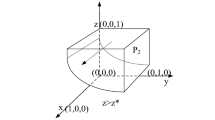Abstract
This study conducts a new evolutionary game analysis for industrial pollution management under dynamic punishment mechanism (DPM), in which the central government’s punishment to the local government is taken into consideration. Then, we compared the two models under the DPM. Moreover, a numerical example is given to illustrate the results. The results show that the evolution path between the local government and the enterprise tends to converge to a stable value under the basic model. Notably, when we add the central government’s punishment to the model, the evolution path between the local government and the enterprise will tend to spiral converge to a stable focus. Thus, the new evolutionary game model that we presented is more conducive than the basic model. The central government’s punishment mechanism will take an active role in dealing with industrial pollution problems.






Similar content being viewed by others
Data availability
The data the authors used in the manuscript are simulated data.
References
Cason T, Friesen L, Gangadharan L (2016) Regulatory performance of audit tournaments and compliance observability. Eur Econ Rev 85:288–306
Chen W, Hu ZH (2018) Using evolutionary game theory to study governments and manufacturers behavioral strategies under various carbon taxes and subsidies. J Clean Prod 201:123–141
Dijkstra BR, Vries FPD (2006) Location choice by households and polluting firms: an evolutionary approach. Eur Econ Rev 50(2):425–446
Estalaki SM, Abed-Elmdoust A, Kerachian R (2015) Developing environmental penalty functions for river water quality management: application of evolutionary game theory. Environ Earth Sci 73(8):4201–4213
Forster BA (2010) Optimal consumption planning in a polluted environment. Econ Rec 49(4):534–545
Friedman Daniel (1991) Evolutionary games in economics. Econometrica 59(3):637
Gilpatric SM, Vossler CA, McKee M (2011) Regulatory enforcement with competitive endogenous saudit mechanisms. Rand J Econ 42(2):292–312
Hamilton WD, May RM (1977) Dispersal in stable habitats. Nature (London) 269(5629):578–581
Kumar A, Patil RS, Dikshit AK et al (2016) Evaluation of control strategies for industrial air pollution sources using American Meteorological Society/Environmental Protection Agency Regulatory Model with simulated meteorology by Weather Research and Forecasting Model. J Clean Prod 116:110–117
Lawlor LR, Smith JM (1976) The coevolution and stability of competing species. Am Nat 110(971):79–99
Lin WT (2010) The control of environmental pollution and optimal investment and employment decisions. Optim Control Appl Methods 8(1):21–36
Lusky R (2001) A model of recycling and pollution control. Can J Econ 9(1):91–101
McGinty M (2010) International environmental agreements as evolutionary games. Environ Resour Econ 45(2):251–269
Milliman SR, Prince R (1989) Firm incentives to promote technological change in pollution control. J Environ Econ Manag 17(3):247–265
Mirmirani M, Oster G (1978) Competition, kin selection, and evolutionary stable strategies. Theor Popul Biol 13(3):304–339
Misiolek WS (1989) Pollution control through price incentives: the role of rent seeking costs in monopoly markets. J Environ Econ Manag 15(1):1–8
Oestreich AM (2015) Firms’ emissions and self-reporting under competitive audit mechanisms. Environ Resour Econ 62(4):949–978
Oestreich AM (2017) On optimal audit mechanisms for environmental taxes. J Environ Econ Manag 84:62–83
Oestreich AM (2017) On optimal audit mechanisms for environmental taxes. J Environ Econ Manag 84:62–83
Plourde C, Yeung D (1989) A model of industrial pollution in a stochastic environment. J Environ Econ Manag 16(2):97–105
Rabanal JP (2017) On the evolution of continuous types under replicator and gradient dynamics: two examples. Dyn Games Appl 7(1):76–92
Rabanal JP, Friedman D (2014) Incomplete information, dynamic stability and the evolution of preferences: two examples. Dyn Games Appl 4(4):448–467
Rabanal JP, Friedman D (2015) How moral codes evolve in a trust game. Games 6(2):150–160
Shen L, Wang Y (2018) Supervision mechanism for pollution behavior of Chinese enterprises based on haze governance. J Clean Prod 197:571–582
Van Der Ploeg F, De Zeeuw AJ (1992) International aspects of pollution control. Environ Resour Econ 2(2):117–139
Wang C, Shi F (2019) An Evolutionary game model for industrial pollution management under two punishment mechanisms. Int J Environ Res Public Health 16(15):2775
Wang H, Cai L, Zeng W (2011) Research on the evolutionary game of environmental pollution in system dynamics model. J Exp Theor Artif Intell 23(1):39–50
Yao DA (1988) Strategic responses to automobile emissions control: a game-theoretic analysis. J Environ Econ Manag 15(4):419–438
Yeung D (1979) A differential game of industrial pollution management. Ann Oper Res 37(1):297–311
Zhang M, Li H (2018) New evolutionary game model of the regional governance of haze pollution in China. Appl Math Model 63:577–590
Acknowledgements
Authors would like to thank the Editor and the anonymous reviewers for their valuable comments and detailed suggestions that have improved the presentation of this paper.
Funding
This work was supported by the Natural Science Foundation of Beijing, China(Grant No.20GLB028)and Beijing Basic Research Funds for universities in Capital University of Economics and Business.
Author information
Authors and Affiliations
Corresponding author
Ethics declarations
Conflict of interest
The authors declare no conflicts of interest.
Additional information
Publisher's Note
Springer Nature remains neutral with regard to jurisdictional claims in published maps and institutional affiliations.
Rights and permissions
About this article
Cite this article
Shi, F., Wang, C. & Yao, C. A New Evolutionary Game Analysis for Industrial Pollution Management Considering the Central Government’s Punishment. Dyn Games Appl 12, 677–688 (2022). https://doi.org/10.1007/s13235-021-00407-x
Accepted:
Published:
Issue Date:
DOI: https://doi.org/10.1007/s13235-021-00407-x




